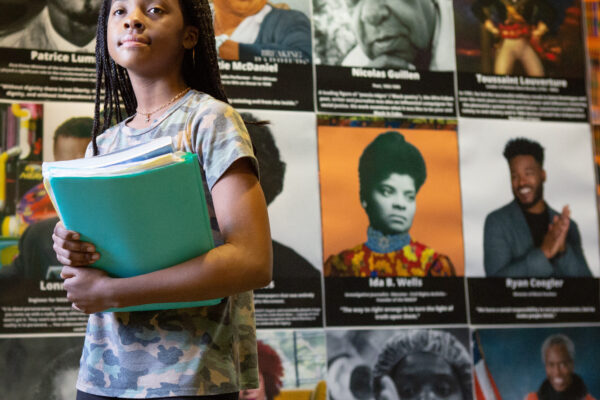Too often, when people hear the words “intellectual rigor,” they associate it with a cantankerous, sage-on-the-stage pedagogy. The most recent pop-culture take on the stereotype appears in “The Holdovers,” the Oscar-nominated story of Paul Tully, played by Dominic Sessa, a struggling teen stuck at boarding school during winter break with only an ancient-civilizations teacher and the school’s cafeteria manager for company.
In the film, Paul Giamatti plays the teacher, Paul Hunham, whose usual classroom practice conflates holding high expectations for learning with berating his students. Hunham shows himself capable of a different angle on teaching when he and Tully visit the Museum of Fine Arts, Boston. Hunham points to an ancient Greek drinking cup on display and asks, “What do you see?”
No spoilers, but let’s just say the images on the cup are pretty standard for the genre, and just as explicit as anything in the graphic novel “Gender Queer,” now the most-banned book in the United States.
Hunham then uses the moment to observe that historical artifacts tap into universal human experiences. “There’s nothing new in human experience, Mr. Tully. Each generation thinks it invented debauchery or suffering or rebellion, but man’s every impulse and appetite from the disgusting to the sublime is on display right here all around you.”
Though Hunham takes up most of the airtime in the scene, it’s Tully’s act of seeing, and connecting what is seen in the object with larger themes, that opens the teenager’s mind to go beyond earning the grades that will keep him out of military school and reflect on what he has in common with people who lived thousands of years ago.
This same practice—observing historical artifacts, discussing them and placing them in a larger context—is key to the intellectual work of the College Board’s AP African American Studies course, which will officially launch this fall after two years of piloting in selected schools.
AP African American Studies has generated plenty of controversy about what history should be taught in high school. But these debates over the course’s content miss its all-too-rare combining of highly engaging subject matter with intellectual rigor. They also miss the careful preparations teachers are making to ensure students do the intellectual work of the course.
Afag Sidahmed, a Sudanese-American junior at Brooklyn’s Urban Assembly Institute of Math and Science for Young Women, told me through a Zoom interview that she values the course’s engaging historical content and greater opportunities for discussion than her previous history courses.
Sidahmed and her AP African American Studies classmates routinely examine primary sources, which could be documents, images, sound or data, teachers Kelly Preston and Martine Mercier told me in a separate Zoom interview. The teachers kick off each day’s study by providing a mini-lesson up front to put the source in historical context. Then they move into guided small-group discussions that create a seminar-style setting where students learn directly from the source as well as from each other’s perspectives and interpretations of the source. “It is much more grounded in what actual historians do,” said Preston.
After the small-group discussions, in a whole-class debrief, students take notes to help retain what they’ve learned. The debrief is also an opportunity to clear up any misconceptions and provide more context. After a recent lesson on Historically Black Colleges and Universities that had students discuss how the institutions supported the advancement of African American communities, Mercier told me, she showed them the substantial numbers of Black judges and members of Congress who were HBCU alumni.
Regular note-taking builds observation, analysis and writing skills, too. “We have to describe what we see, what we learned, and how our point of view has changed. Writing every day like that improves your writing skill,” said Sidahmed.
To create this environment, Preston and Mercier prep relentlessly. Their goal, as Preston put it, is to ensure “students do the heavy intellectual lifting of discussing, thinking, and having these debates so that they can really grapple with the information.”
A key element of their lesson planning involves designing questions to push all kids to their highest levels of thinking. Preston said, “We think about kids who might struggle, or kids who are way above, and think, “OK, what questions can we ask to support them in meeting expectations, or pushing them higher without giving away the answer?”
Through communication with other AP African American Studies teachers, Preston and Mercier are learning ways to push their students even deeper into the work of the course. Preston said she is now considering having students prepare the day’s introductory mini-lessons, after having seen it work in another teacher’s course at a different school.
The course has changed Sidahmed’s expectations about college, too. “I used to look at college like, ‘Oh, it’s scary.’ You’re going to be in a room full of a hundred people and you’re just all by yourself. You’re doing the work all by yourself,” she said. “I didn’t think you would be doing a lot of group discussions and talking with others.”
At a time when many high school students are disengaged and struggling, it’s notable how AP African American Studies at the Urban Assembly Institute of Math and Science for Young Women fosters students’ deeper understanding of the humanities. Back in Boston, at the museum, Hunham advises Tully, “Remember, if you truly want to understand the present or yourself, you must begin in the past. You see, history is not simply the study of the past; it is the explanation of the present.” Whether the history under study took place in ancient Greece, or ancient Africa, Hunham’s point applies.

